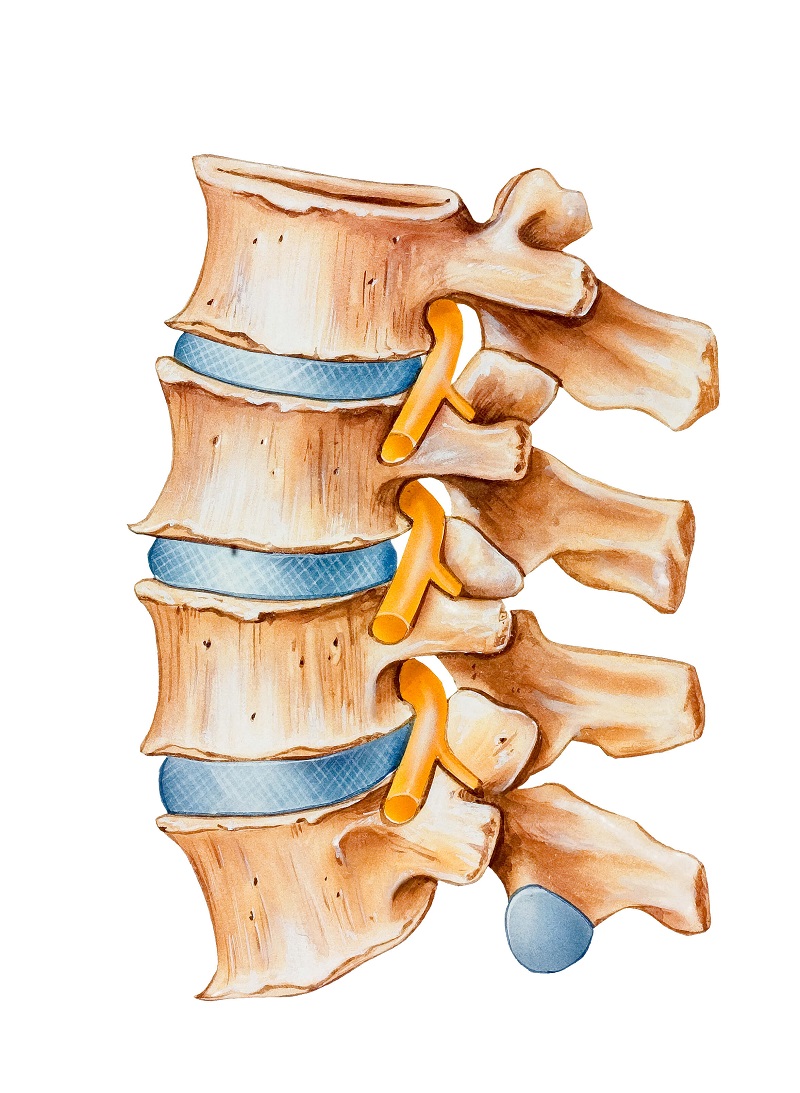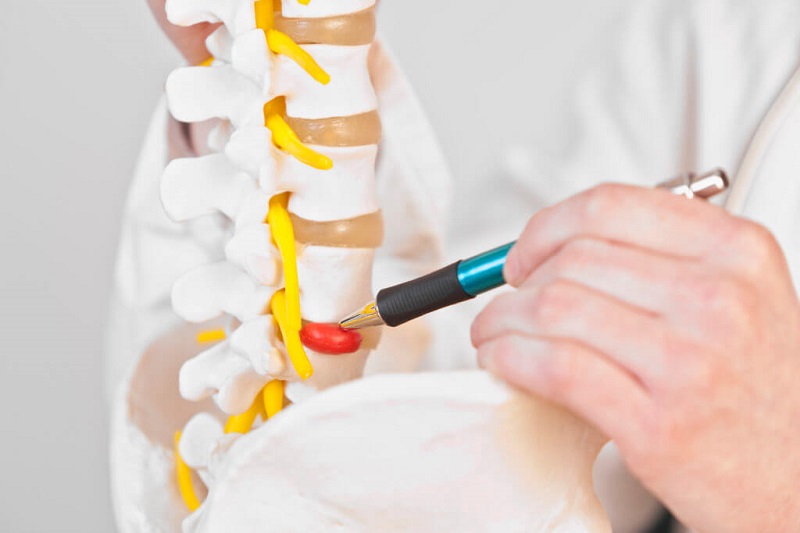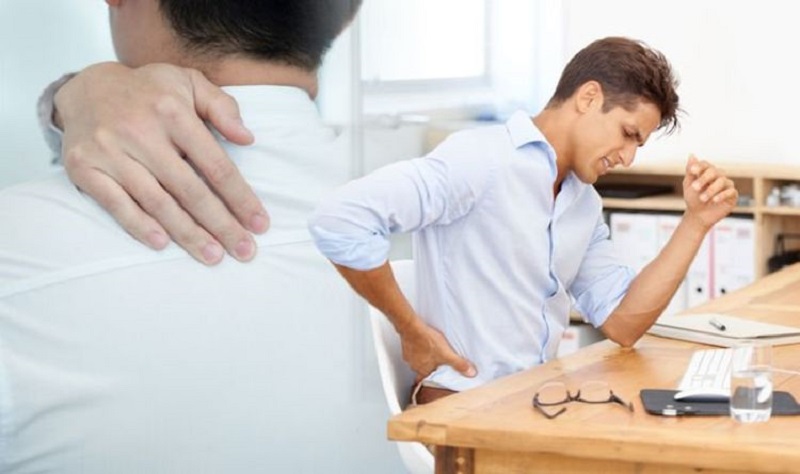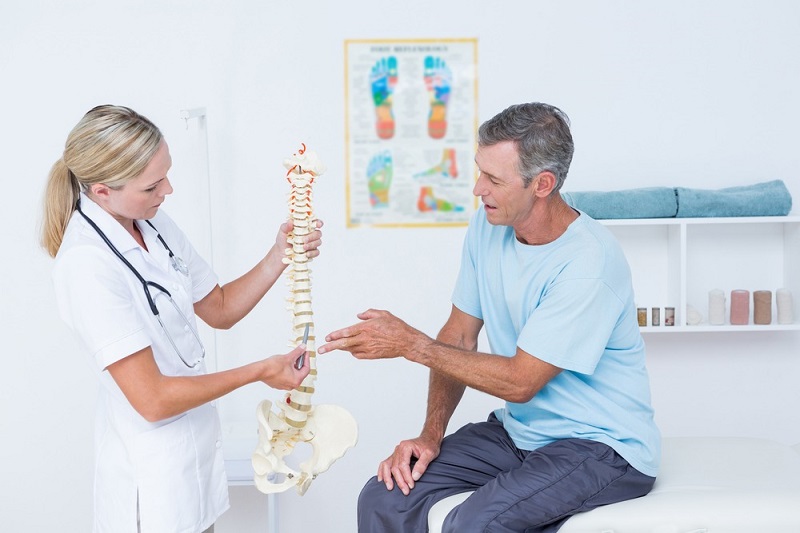At present, the rate of people suffering from herniation is increasing. Not only the aging process is common in the elderly, but also people of working age are also at high risk of this disease.
Recognizing early signs of lumbar disc herniation is helping the treatment process to be highly effective at the first stage to limit the dangerous complications, the most serious being lifelong disability.
Mechanism of Disc Herniation
The human spine is like a pillar that plays an important role in helping to support the body. Connections between vertebrae are provided with discs of good elasticity.
Thanks to the special structure of the spine shaped almost like an S-shaped, it is possible to disperse the forces acting on the spine, reducing the tremors on the lower limbs when we are in the upright position. people.
The spinal disc has a round and flat shape is composed of 3 main components: the disc mucus is located in the center, the thick, firm filament ring, and the cartilage tip.
The disc acts as a cushion between two adjacent vertebrae, highly resilient and deformed under the effects of thrust, compression, and protects the spine thanks to its damping ability. on the body of the vertebrae.

When the outer fibrous sac of the disc is torn, torn, forming gaps, allowing the inner mucous core to flush out at high pressure and fast speed. This process forms a herniated mass that penetrates the inside of the spinal canal, causing compression on the nerve root and medullary membrane, a condition known as a herniated disc.
Any segment of the spine can experience disc herniation, but the most common locations are lumbar L4 – L5, S1, and cervical vertebrae due to constant bad habits. The date affects, or may also be related to, weaknesses such as age, trauma.
Stage of Disc Herniation
How painful is a herniated disc? Disc herniation is divided into 4 main stages, ranging from mild to severe, with progressive pain manifestations as follows:
Stage 1: Spinal disc begins to deform gradually, but at this stage, the fibrous outer ring has not been torn. Patients sometimes feel numb in their arms and legs. Because there is no pain in the early stages, people often fail to notice that they have the disease.
Stage 2: In stage 2, the outer ring of the fiber is partially torn, allowing the mucous core a chance to escape through the weakened fibrous ring. At the same time, the disc is enlarged, but the pain is often very vague, difficult to recognize.

Stage 3: Disc herniation in the stage is severe, the fibrous ring is completely torn, the inner mucous core protrudes out, causing pressure on the nerve roots. Usually, cases of disc herniation enter this stage for the patient to experience prolonged pain, so it is discovered and treated.
Stage 4: This is the most serious stage. Long-term pinched nerve roots without treatment, causing dangerous complications. The patient suffers from severe pain for a long time and excruciatingly affects the health, spirit, and quality of life.
Causes of Disc Herniation Pain
Disc herniation can be caused by the following causes:
Wrong posture: During work, sitting in the wrong position for too long or carrying heavy objects will increase the risk of spinal injury, causing a disc herniation.
Injury: When there is an external force impacting the spinal area in such cases as falls, accidents, sports … will change the structural position of the disc, causing injury and increased risk of disc herniation.
The natural degeneration process: Aging takes place, the older the spine becomes functional, no longer soft, begins to fiber, thick fluid, and less elasticity, increasing a greater risk of disc herniation than younger people. Age usually with disc herniation is usually between 35-50 years old.
In addition, there are factors that increase your risk of disease to look out for such as:
Overweight: Being overweight, obesity causes severe pressure on the spine and increases the risk of disc herniation 12 times higher than in good weight control.
There are spinal diseases: Some diseases such as spina bifida, scoliosis, degenerative spine … also increase the risk of disc herniation.
Occupation: The repetitive work of companionship such as pulling, pushing, carrying, bending, sitting for a long time, being sedentary for a long time will increase the pressure in the spine, which is susceptible to disc herniation.

Wearing high heels: If you wear heels that are too high and often there is a risk of disc herniation, deformity of calf muscles, leg ligaments, and disc bulging. To limit this risk, you should choose the right shoe style, do not wear too high or for too long, at the end of the day massage can help relax your feet.
Signs of Disc Herniation
Disc herniation is common in the lumbar region and the cervical spine. For the lumbar spine, there will be symptoms such as:
Dull pain that spreads in the lower back or comes suddenly and very severe.
- Low back pain is often accompanied by signs of sciatica, pain often spread in an arc, spreading to the front of the chest, along with the intercostal space.
- Patients with weak limbs, feeling numb, difficult to flex, often feel clearly in the instep and buttocks.
- The pain usually increases with sitting, sudden action, coughing, lying on your side. Patients often have to stand sideways to relieve pain.
- For cervical disc herniation, the patient may notice symptoms such as:
- The neck area is stiff, aching pain spreading to the shoulder and neck down to the shoulder blades.
- Thumb and wrist numbness, and sometimes numb, painful areas.
- Limiting arm movement, difficulty in the use of inflexible hand force, weak arm muscles.
- In a few cases, in addition to neck pain, the patient also suffers from dizziness and headache.
Tearing The Fiber Bag Can Heal?
When the tearing of the disc, it means that the herniation has progressed to a dangerous stage, there is a risk of unpredictable complications, affecting the health of the patient. Therefore, many people wonder if tearing the fibrous disc can heal?
The treatment regimen for tearing the fibrous disc will depend on the large or small tear condition, the severity of the disc damage, and also determine the success and duration of treatment in different cases.
In mild cases, the tear is small and the mucus has not come out, the method used is usually medication, to prevent the disease from progressing to a more dangerous stage and limit complications.
In severe cases, prolonged chronic disc herniation causes the mucous nucleus to almost completely escape, causing compression of nerve roots, the treatment process will become complicated, prolonged, and affect the strength. the health of the patient.
Thus, tearing the fibrous disc can not be healed, but the main treatment is to minimize symptoms, prevent complications, and change living habits to support the treatment process to achieve high results.
How To Treat Disc Herniation?
How to cure pinched nerve when disc herniation is like? Having a herniated disc causes pressure on the nerve roots. Depending on the stage of the disease, a doctor will have to diagnose a specific condition before it can come up with an appropriate treatment regimen.
1. Treatment of disc herniation without medication
Most cases of disc herniation will not require surgery. The applied method is to practice according to a specific schedule as prescribed by the doctor or can be accompanied by medication to help reduce symptoms of the disease and prevent affecting other organs. The methods given are usually:
-
Yoga: Can be combined with appropriate physical movements, meditation, breathing exercises to help restore musculoskeletal function and reduce pain.

- Chiropractic method of manipulation of joints: Helps improve lower back pain in moderation. But need to follow the guidance of a doctor. Also in very rare cases, the chiropractic method of treating patients with a cervical disc herniation can cause a stroke.
- Acupuncture: Helps relieve neck pain and back pain quite effectively.
2. Treatment of disc herniation with medication
Your doctor will prescribe a number of medications during the treatment of disc herniation such as:
- The drug has analgesic and anti-inflammatory effects.
- Antiepileptic drugs.
- Some cases of spastic spasticity are indicated to use drugs that work to relax muscles.
- Corticosteroids epidural analgesic injection: This is a powerful anti-inflammatory drug, helping to quickly reduce symptoms of herniation.
Surgical treatment
When the disc herniation is so severe that compresses the entire nerve root in the ponytail, causing complications, and causing the patient to lose the pain, the recommended method is usually surgery to help prevent dangerous complications. dangerous. Or when conserving methods, medications, and physical therapy are ineffective, they will also be considered for surgical indications.

Do many patients worry that disc herniation surgery is dangerous? Surgery is considered the last resort treatment to prevent complications and relieve pain. Currently, with the advancement of the medical background, disc herniation surgery has a rather high success rate up to 90 – 95%, the recurrence rate of the disease is only about 5-10%.
However, the patient may experience complications after disc herniation surgery such as:
- Postoperative infections: wound infection, infection inside the spine, infection in the intervertebral disc.
- Complications recurrence after surgery.
- The appearance of prolonged pain.
Disc herniation is a condition that cannot be taken lightly as it can be found in anyone, not just the elderly. To limit complications when the disease progresses to a severe stage, changes to chronic or experiences complications after surgery, the patient should pay attention to the early signs of the disease and come to the hospital for prompt diagnosis immediately at the first stage of the disease.
Please find the nearby location or the nearest branch your home to visit for tests and get quick online results. For more detailed information about our test menu and price list, click here.
The site cannot and does not contain medical advice. The medical information is provided for general informational and educational purposes only and is not a substitute for professional advice. Accordingly, before taking any actions based upon such information. We encourage you to consult with the appropriate professionals.

 1900 1717
1900 1717 
